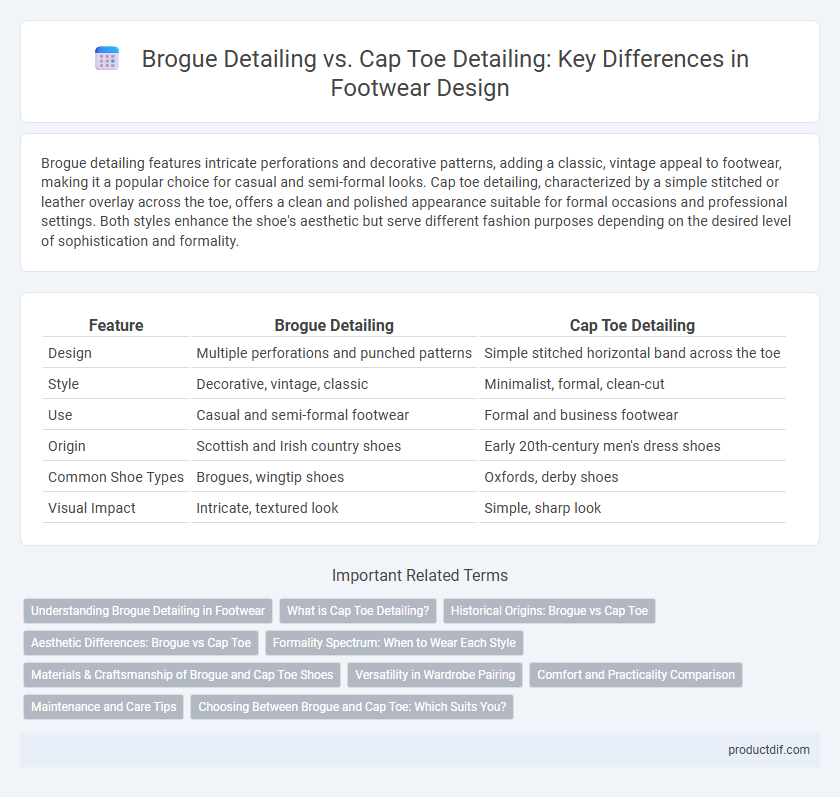Brogue detailing features intricate perforations and decorative patterns, adding a classic, vintage appeal to footwear, making it a popular choice for casual and semi-formal looks. Cap toe detailing, characterized by a simple stitched or leather overlay across the toe, offers a clean and polished appearance suitable for formal occasions and professional settings. Both styles enhance the shoe's aesthetic but serve different fashion purposes depending on the desired level of sophistication and formality.
Table of Comparison
| Feature | Brogue Detailing | Cap Toe Detailing |
|---|---|---|
| Design | Multiple perforations and punched patterns | Simple stitched horizontal band across the toe |
| Style | Decorative, vintage, classic | Minimalist, formal, clean-cut |
| Use | Casual and semi-formal footwear | Formal and business footwear |
| Origin | Scottish and Irish country shoes | Early 20th-century men's dress shoes |
| Common Shoe Types | Brogues, wingtip shoes | Oxfords, derby shoes |
| Visual Impact | Intricate, textured look | Simple, sharp look |
Understanding Brogue Detailing in Footwear
Brogue detailing in footwear features decorative perforations and serrations along the edges of leather pieces, originally designed for water drainage in Irish and Scottish outdoor shoes. This intricate pattern enhances both aesthetic appeal and ventilation, distinguishing brogues from cap toe designs, which primarily focus on a plain leather extension across the toe for a sleek, formal look. Understanding brogue detailing helps buyers appreciate the blend of style and functionality unique to classic and modern brogue shoes.
What is Cap Toe Detailing?
Cap toe detailing on footwear features a distinct horizontal stitch across the toe box, creating a separate section at the front of the shoe that enhances its formal and structured appearance. This design is commonly found in Oxford and Derby shoes, providing a sleek and polished look ideal for professional and dress occasions. Compared to brogue detailing, which incorporates perforations and decorative patterns, cap toe detailing emphasizes clean lines and minimalism.
Historical Origins: Brogue vs Cap Toe
Brogue detailing originated in Scotland and Ireland, initially designed for outdoor wear with perforations to allow water drainage from shoes. Cap toe detailing emerged from English tailoring, characterized by a horizontal stitch across the toe, symbolizing structure and formality in dress shoes. Both designs reflect distinct cultural histories influencing their function and aesthetic evolution in contemporary footwear.
Aesthetic Differences: Brogue vs Cap Toe
Brogue detailing features intricate perforations and serrations along the shoe seams, creating a decorative and textured appearance that enhances classic and vintage aesthetics. Cap toe detailing, characterized by a smooth, unadorned leather overlay across the toe box, offers a clean, minimalist look that exudes formality and sophistication. While brogue designs emphasize ornamental craftsmanship, cap toe styles prioritize simplicity and sleekness in footwear aesthetics.
Formality Spectrum: When to Wear Each Style
Brogue detailing features decorative perforations and serrations, making these shoes ideal for smart-casual and business-casual settings where a touch of personality is appropriate, but not overly formal. Cap toe detailing offers a sleek, simple design with a distinct horizontal seam across the toe, placing it higher on the formality spectrum, suitable for business formal and black-tie events. Selecting brogue shoes aligns with less formal occasions, while cap toe shoes complement professional environments requiring polished, understated elegance.
Materials & Craftsmanship of Brogue and Cap Toe Shoes
Brogue detailing typically features perforations and serrations crafted from high-quality full-grain leather that emphasizes intricate hand-stitching and precision punching techniques, showcasing expert craftsmanship. Cap toe shoes often use smooth, polished calfskin or patent leather with a distinct, reinforced toe section, highlighting refined stitching methods that enhance durability and sleek design. Both styles demand expert material selection and meticulous craftsmanship to balance aesthetics with functional wearability.
Versatility in Wardrobe Pairing
Brogue detailing offers intricate perforations that add texture and character, making these shoes ideal for smart-casual and semi-formal outfits. Cap toe detailing features a distinct toe cap, providing a sleek and minimalistic look that pairs effortlessly with formal suits and business attire. Both styles enhance versatility in wardrobe pairing by addressing different dress codes and occasions, allowing for a balanced rotation of footwear options.
Comfort and Practicality Comparison
Brogue detailing features perforations that enhance breathability, making the shoes more comfortable for extended wear, especially in warmer conditions. Cap toe detailing provides additional structure and protection at the front, offering practical durability without sacrificing comfort. Both styles balance aesthetic appeal with functional benefits, but brogues typically excel in ventilation while cap toes prioritize reinforcement.
Maintenance and Care Tips
Brogue detailing, characterized by perforations and serrations, requires regular cleaning with a soft brush to remove dirt lodged in the holes, followed by conditioning to prevent leather dryness. Cap toe detailing involves a smooth leather overlay that benefits from frequent polishing to maintain its shine and protect against scuffs, with occasional use of leather cream to preserve flexibility. For both styles, using a shoe tree helps maintain shape and absorb moisture, extending the life of the footwear.
Choosing Between Brogue and Cap Toe: Which Suits You?
Brogue detailing features decorative perforations and serrations along the edges, adding a vintage, rugged aesthetic ideal for casual or smart-casual footwear, while cap toe detailing offers a clean, polished look with a stitched horizontal panel across the toe, perfect for formal and business settings. Choosing between brogue and cap toe depends on your wardrobe versatility and occasion needs; brogues pair well with jeans and chinos, whereas cap toe shoes complement suits and dress pants. Consider personal style preferences and dress code requirements to determine which detailing enhances your overall outfit best.
Brogue detailing vs Cap toe detailing Infographic

 productdif.com
productdif.com